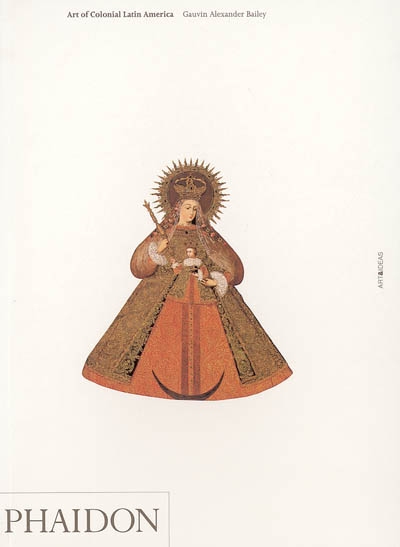par Bailey, Gauvin Alexander (1966-....)
Phaidon
-
-
Disponible - 708-5 BAI
Niveau 3 - Arts
par Bailey, Gauvin Alexander (1966-....)
Phaidon
-
Disponible - 708-5 BAI
Niveau 3 - Arts

Présente en huit chapitres l'art de l'Amérique latine à l'époque coloniale sur lequel s'est fondé l'art moderne du pays : le monde pré-hispanique et la scène coloniale, l'art indigène, l'art des vice-rois, l'art des académies, l'art religieux, les églises des grandes villes, les arts de l'aristocratie coloniale et l'art ibérique en Asie et en Afrique.

For over three hundred years, from the era of Christopher Columbus to the struggles for independence around 1820, Latin America witnessed an artistic flowering of enormous creativity and originality. In a unique way, the art and architecture of Aztec, Inca and Guaraní civilizations blended with those of Europe, North Africa and the Far East. In particular, the Spanish and Portuguese empires in Central and South America created the climate for a flourishing, diverse and distinct version of Renaissance and Baroque culture, produced under utterly different social and geographic conditions from those found in Europe. The products of this culture include some of the most lavish and visually arresting works of art and architecture in the world.
In this lively overview of the tremendously rich and varied artistic output of the area from southern Chile to northern California, Gauvin Alexander Bailey discusses viceregal and missionary as well as civic and rural architecture, alongside religious and secular painting, sculpture, metalwork, textiles and ceramics. But he also looks back to pre-colonial influences and concludes with an examination of how twentieth-century artists such as Diego Rivera and Frida Kahlo interpreted their artistic heritage. Even today, the art of the colonial period remains at the centre of Latin American society, culture and identity. The result is a book that provides a new and comprehensive understanding of all the influences that led to one of the most cosmopolitan artistic outpourings in the whole history of art.
Comprehensive introductions to world art
Recommended for students and anyone curious about art
Written by internationally respected scholars
Up-to-date and informative
Enjoyable to read and free from jargon
Excellent for exploring the ideas behind visual forms
Ideal for understanding art in its historical context
Produced to the highest quality in art publishing
Art & Ideas is a groundbreaking series that offers up-to-date, authoritative, enjoyable and thought-provoking books on every aspect of the history of art around the world. Written by outstanding scholars, these lively and highly illustrated books place art and architecture firmly in the context of the culture and ideas in which they were created. The books are concerned not just with the appearance of works of art, but with their functions and meanings for the men and women who commissioned, made, used and responded to them in varied places and eras. Within each book all the visual arts - architecture, painting, sculpture, graphic art and the applied arts - are considered together. Although each book is a self-sufficient survey of its subject, the series has been carefully planned to build into a complete introduction to world art.
Disponible - 708-5 BAI
Niveau 3 - Arts